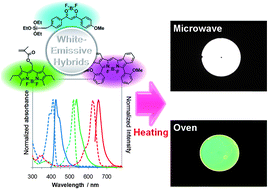Efficient simultaneous emission from RGB-emitting organoboron dyes incorporated into organic–inorganic hybrids and preparation of white light-emitting materials†
Abstract
In order to investigate dye-dispersion behaviors in organic–inorganic hybrids, we incorporated RGB light-emitting organoboron dyes (1,3-diketonate BF2 complex, borondipyrromethene (BODIPY), and boron di(iso)indomethene as blue, green and red light-emitting dyes, respectively) into poly(2-hydroxyethyl methacylate) (PHEMA)–silica hybrids prepared by the microwave-assisted technique. Photoluminescence spectra of two dyes in various concentrations and Stern–Volmer plots indicate that the energy transfer efficiencies between the dyes in the hybrids were lower than that in the solution state, resulting from the suppression of concentration-quenching. Furthermore, we demonstrate the color tuning for preparing white light-emitting hybrids based on simultaneous RGB light-emission of the organoboron dyes. Finally, pure white light-emitting hybrids were obtained by the microwave-assisted in situ method.


 Please wait while we load your content...
Please wait while we load your content...